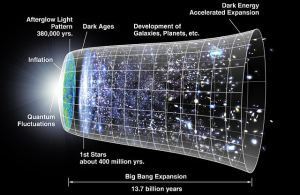Kate Rauner's Blog, page 99
April 5, 2014
Citizen Scientists Appreciated by the Professionals
I recently attended an interesting lecture by Dr Bill Norris of Western New Mexico University on the role of the citizen scientist in botany. You may think of citizen scientists as belonging to a bygone era, aristocrats and country parsons dressed in prim Victorian frock coats collecting barnacles and butterflies, but they are still needed today. The ranks of field botanists are thinning. There are fewer academic positions available each year and there is a trend for botanists to go into laboratory work; important work, but not traditional botany.
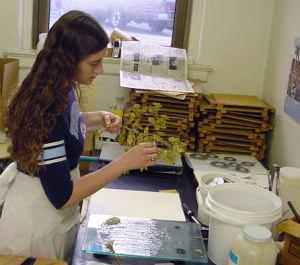
Preparing a herbarium specimen
Bill shared the stories of several citizen botanists he works with; retired individuals with a passion for field work. They include some people who had STEM careers (for example, a medical doctor and an astronomer) but the most successful so far is a retired postal worker. They perform detailed field work: collecting plants, noting details such as when and where they grow and flower, and what other plants grow with them. They preserve their specimens for future research, and sometimes contact international experts to help identify a plant. One species new to science was discovered by a citizen in a well-used state park, so there are discoveries to be made practically in your back yard. Citizen scientists even publish papers in peer-reviewed journals and win awards. Their inventories of plants will help us understand changes in diversity and distribution, prepare popular field guides, and recognize key identifying features.
There are estimated to be over four thousand species of plants in New Mexico but only three professional academic field botanists and another four or five botanists working for federal agencies. That leaves a lot of room for the citizen botanist to make lasting contributions to science. You, too may have a second career or passionate avocation in science.








April 2, 2014
Crow and Pitcher – a poem by Kate Rauner
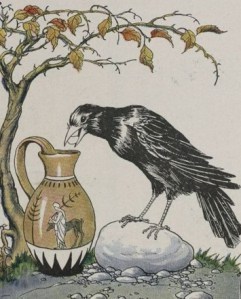
From Project Gutenberg, copyright expired in US
Fabled stories of Aesop tell
Wisdom ancient Greeks knew well.
Show humble acts teach great truths
With animals foolish or astute.
From half-full pitchers crows can drink.
They raise the level with rocks that sink
Now researchers at Aukland U,
Are crows that smart? They wonder, too.
Float snacks inside a narrow tube,
Give floating blocks and sinking cubes.
Crows figure out, to get their treat,
Drop sinkers in, just like the Greeks.
Necessity, mother of invention,
Gives 5-year olds some competition.








March 30, 2014
New Web Site to Check Out
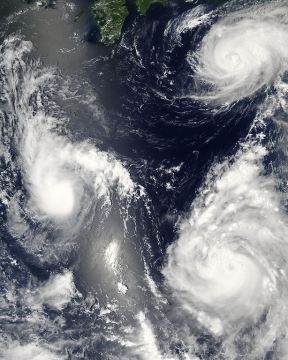
Here comes a natural disaster – image from NASA
Nate Silver’s fame spread from sports to politics during the last American presidential election when he accurately predicted the outcome despite a blizzard of conflicting public opinion polls. He edits a website at http://fivethirtyeight.com/ (owned by ESPN) that looks like a great magazine. The writers apply science and statistics, to popular topics. This gives an average reader a chance to evaluate the barrage of news, self-serving diatribe, and just plain nonsense from the media. From NCAA brackets to climate change, you’ll find interesting articles that can be of practical use.
Here’s one example: News about health seems to be full of “breakthroughs” that never arrive and contradictions that arrive frequently. What health news can you use? “Headlines are advertising. The goal is to get you to read the article, not necessarily to represent the research accurately.” But there are six criteria you can use to evaluate an article about medical studies. One is: Was the study performed on people? The more “yes” answers, the more likely the study is important to you.
Here’s another example: An article (by a writer with qualifications in the field) disputing recent claims that climate change is responsible for economic losses increasing due to natural disasters “generated a lot of comments and questions, and I thought it would be good to address some of them. Human-caused climate change is both real and important, so being careful about what claims science can support and which it can’t is imperative.” Hurray! Rational discussion of the facts and not just red team/blue team bumper stickers. FiveThirtyEight provided links to rebuttals and even plans to publish its own rebuttal to the original article.
I think reality is important, so this site looks like a great resource. Check it out.








March 26, 2014
Cosmic Inflation – a Poem by Kate Rauner

The new series Cosmos-A Spacetime Odyssey confronts inflation in the instant after the Big Bang. Courtesy Fox.
Since Pezias and Wilson
Chased the pigeons off their dish
And listened to the sound
Of the cosmic hiss,
The Big Bang’s been our vision
Of the moment of creation;
Now we have the signature
Of cosmological inflation.
What the human eye can see
Is just a fraction of creation,
But we can build telescopes
To see more radiation.
Patterns swirling in the light
Where gravity flows through
Could unite relativity
With the quantum view.
Space itself expanded faster
Than the speed of light;
We still need confirming work
To prove the study right.
But Einstein’s great mistake
Seems more and more correct.
Could dark energy be a remnant?
That’s what we’ll puzzle next.
It won’t change my life tomorrow,
Won’t put cream into my tea;
I believe knowledge is better
Than ignorance can be.
Robert Wilson talks about the discovery here and there’s more here and here








March 24, 2014
Citizen Scientist
The Atlantic recently posted a contrarian article. Author Michael S. Teitelbaum says the “conventional wisdom” that America has a shortage of math, science, and engineering professionals is just echo-chamber hearsay and not true at all. “A compelling body of research is now available, from many leading academic researchers and from respected research organizations such as the National Bureau of Economic Research, the RAND Corporation, and the Urban Institute. No one has been able to find any evidence indicating current widespread labor market shortages or hiring difficulties in science and engineering occupations that require bachelors degrees or higher.”
When I entered engineering in the late 1970s, I expected the profession to be a boom and bust profession. Although I was lucky with my employment, Teitelbaum documents three “boom/bust” cycles during my career.

Some amateurs carry their passions to great lengths
This does not mean that students should ignore their science and math courses. I agree with Teitelbaum that “Every high school graduate should be competent in science and mathematics—essential to success in almost any 21st century occupation and to informed citizenship as well.” We live in a world that increasingly relies on technologies that few of us understand, which can leave people feeling helpless and victimized; easy prey for conspiracy theories, magical thinking, and charismatic crackpots.
We all need to make a living and we all hope to follow our dreams.  Sometimes we can’t bring those two things together into a single career, but we have an opportunity to learn and participate as a citizen-scientist no matter what our education or job. I contribute to CoCoRaHS; what’s your interest?
Sometimes we can’t bring those two things together into a single career, but we have an opportunity to learn and participate as a citizen-scientist no matter what our education or job. I contribute to CoCoRaHS; what’s your interest?








March 22, 2014
Cosmos is Worth Watching
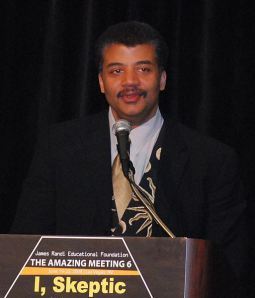
Tyson, with his famous sun and moon vest peeking out of his jacket
Are you watching Neil DeGrasse Tyson’s remake of Carl Sagan’s iconic mini-series Cosmos? You should.
The theme of the first episode was that space-time is really, really big. The episode received excellent reviews and I agree: the special effects and cinematography were stunning (“faster, brighter, and more explosive” as Wired says), though the use of cartoon animation to present a historical story struck me as less compelling than live action would have been. There seem to be high hopes that the new Cosmos will rekindle America’s love affair with science, as anecdotes (if not rigorous studies) suggest the original Cosmos did.
The second episode tackled a fundamental principle that also has religious implications for some people: evolution. Cosmos did not shy away, mentioning Darwin and our chimp relatives as well as a nicely done segment on the evolution of the mammal eye. Personally, I have never understood why some people want to limit god to an old book. As 16th-century philosopher Giordano Bruno said to his persecutors in the first episode, “your god is too small.”
The second episode covered some profound topics, like the five great extinctions on Earth, presented as displays in a solemn museum-like pyramid. The episode also presented a fascinating small creature, the tardigrade, the only creature known that can survive, unprotected, in space. Maybe the producers won’t allow an entire episode to be set on Earth; there was a quick trip to the hydrocarbon seas of Saturn’s moon Titan. Again, the animated cartoon (dogs becoming domesticated) seemed the weakest part of the show.

Tyson confronts The Big Bang, courtesy Fox
Five years ago, Fox wouldn’t have made Cosmos, Tyson said in a recent interview. Today, we geeks are fashionable. “The geeks have found each other.” Hurray at last; it’s good to have friends who understand.
I like Tyson’s Cosmos and will watch the rest of the series. I’m not sure what impact the original Cosmos had; we geeks also found inspiration in Star Trek. I plan to simply enjoy the new Cosmos and not burden it with expectations of inspiring a generation or solving America’s political problems.
Cosmos airs at 9 p.m. ET on Fox on Sundays. It will re-air on Mondays on the National Geographic Channel at 10 p.m. ET. Does anyone have information on international showings?








March 19, 2014
Within Ourselves – a poem by Kate Rauner
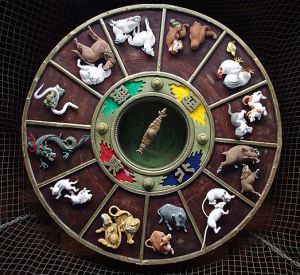
Chinese Zodiac
Do the planets mark our hours?
Set our weaknesses, our powers?
From Babylon by way of Rome,
Or from the Middle Kingdom’s home,
From jyotish of Hindustan,
Come horoscopes on vendors’ stands.
Feckless woman, foolish man;
What chance provides, take in your hand.
Mishaps and luck, our loves and fears
Dance not to music of the spheres.
You will find, if you delve,
“The fault not in our stars, but in ourselves.”
I end this poem with a paraphrase of the famous line from Shakespeare‘s play Julius Caesar (Act 1, scene 2). The nobleman Cassius says to Brutus, ‘The fault, dear Brutus, is not in our stars, / But in ourselves, that we are underlings.’ I thought the words I used were close enough to deserve quotation marks.
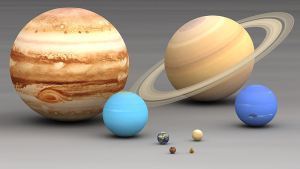
Comparison of the sizes of planets, from Wikipedia
March 15, 2014
Retro Rocket

Buck Rogers operating a drone, Amazing Stories (March 1929)
SpaceX has been delivering cargo via rocket to the International Space Station, but that is old news. What’s new is how the first stage will be retrieved for reuse: it’s going to land with spindly-looking legs on a tail of flame. The first time, SpaceX will land the rocket in the ocean, but once the system is proven, the rocket will set down on land. If someone wrote about such a rocket in a science fiction story today, you might scoff at the antiquated, Buck Rogerish idea. “If SpaceX can create a completely reusable rocket, [a researcher] believes their prices will drop so significantly that it will put out of business any company that doesn’t keep up”. Truth really is cooler than fiction.








March 12, 2014
Far From Home- a poem by Kate Rauner
A young man, soldier, far from home;
Is he homesick? Feel alone?
The climate’s cold, the people odd,
Strange trees and birds, and even gods.
Writes to his mother, sister, brother;
Writes one letter, then another.
“I pray that you all are well…”
A small and private tale to tell.
His letter hints at some discord;
“You don’t write back…” these are his words.
What war was this? What campaign?
Congo? Kosovo? Iran?
Two thousand years have passed to dust
Since he fought, wrong or just,
From a European post,
Far from Egypt’s sunny coast.
“I’ll ask for leave… I’ll come to you…”
We’ll never know: what did he do?
Buried for two thousand years,
Papyrus from the wild frontier,
From ruins dug the letter came,
From families gone into our hands.
Translation new; familiar nerve
In the hearts of those who serve.

Imperial Roman soldiers, carved on Trajan’s Column
www.livescience.com with thanks to Grant Adamson for his translation








March 8, 2014
Cool Roofs or Green Roofs?
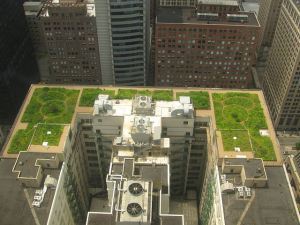
Green roof of City Hall in Chicago, Illinois.
Whether intended to help save the world from global warming or just to lower electric bills, roof materials are in the news. “Cool roofs are made of materials… that reflect much of the sunlight they receive back into space. Green roofs incorporate vegetation to keep a building cool and provide moisture to the atmosphere that cools their surroundings.” (CSM) While not every roof can be retrofitted and new construction seldom uses these types of roofs, scientists have modeled what might happen if every roof were suddenly cool or green. Which would be “better”? It’s not obvious. Cool roofs may lower summer air conditioning, but increase winter heating bills. Green roofs are heavy and can be difficult to construct, but by holding moisture they may increase local rainfall. Either way, roof choices will have an infinitesimal effect on global warming, so the immediate impact on the building’s residents will dictate which is best. That, and your budget.









